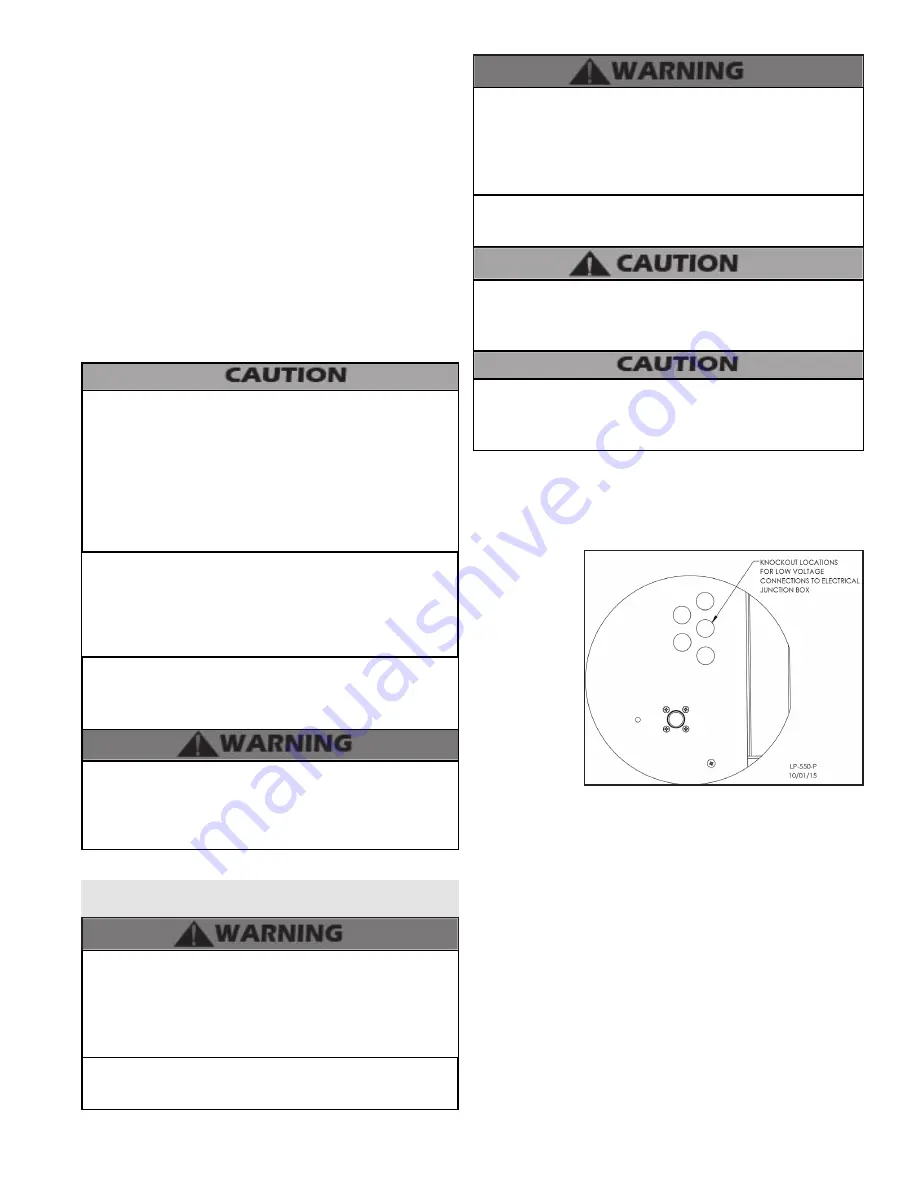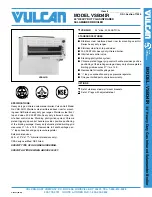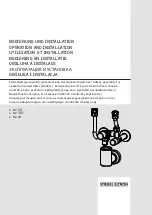
WHL-052 Rev. 4.28.16
33
The condensate line must remain unobstructed. If allowed
to freeze in the line or obstructed in any other manner,
condensate can exit from the boiler tee, resulting in potential
water damage to property. When installing a condensate
pump, select one approved for use with condensing boilers
and furnaces. The condensate pump should have an overflow
switch to prevent property damage from spillage. Condensate
from the boiler will be slightly acidic (pH from 3.2 to 4.5).
Install a neutralizing filter if required by local codes.
Power to the optional condensate pump is continuous. When
the boiler is powered off the condensate pump will remain on.
It is important to remember to turn off the condensate pump
when powering down the boiler. Failure to do so could result
in property damage, severe personal injury, or death.
3. A frozen condensate line could result in a blocked vent
condition. It is very important to protect the condensate
line from freezing temperatures or any type of blockage.
In installations that may encounter sustained freezing
conditions, the use of heat tape is recommended to avoid
freezing of the condensate line. It is also recommended to bush
up the condensate line size to 1” and terminate condensate
discharge as close to the unit as possible. Longer condensate
runs are more prone to freezing. Damages due to frozen or
blocked condensate lines ARE NOT covered by warranty.
4. Support of the condensate line may be necessary to avoid
blockage of the condensate flow.
5. To allow proper drainage on longer horizontal condensate
runs, tubing size may need to increase to 1” and a second line
vent may be required.
NOTE:
To clean out condensate trap, see Maintenance
section.
Is is very important that condensate piping be no smaller
than 1/2”. Use a tee at the condensate connection with a
branch vertically up and open to the atmosphere to prevent a
vacuum that could obstruct the flow of condensate from the
boiler. To prevent sagging and maintain pitch, condensate
piping should be supported with pipe supports.
When installing a condensate pump, select one approved for
use with condensing boilers and furnaces. The pump should
have an overflow switch to prevent property damage from
condensate spillage.
Part 6 - Wiring
To avoid electrical shock, turn off all power to the boiler prior
to opening an electrical box within the unit. Ensure the power
remains off while any wiring connections are being made.
Failure to follow these instructions could result in component
or product failure, serious injury, or death. Such product
failure IS NOT covered by warranty.
Jumping out control circuits or components WILL VOID
product warranty and can result in property damage, personal
injury, or death.
Label all wires prior to disconnecting them when servicing
the boiler. Wiring errors can cause improper and dangerous
operation. Failure to follow these instructions may result in
property damage or personal injury.
It is of extreme importance that this unit be properly grounded. It
is very important that the building system ground is inspected by
a qualified electrician prior to making this connection. Electrical
power must only be turned on when the boiler is completely
filled with cold water. Failure to follow these instructions could
result in component or product failure, serious injury, or death.
Electrical Shock Hazard
- Turn off electrical power supply at
service entrance panel before making any electrical connections.
Failure to follow do do so could result in serious injury, or death.
Wiring must be NEC Class 1. If original wiring supplied with the
boiler must be replaced, use only TEW 105
o
C wire or equivalent.
Boiler must be electrically grounded as required by the National
Electrical Code, ANSI/NFPA 70 - Latest Edition.
A. Installation Must Comply With
1. National Electrical Code and any other national, state,
provincial, or local codes or regulations.
2. In Canada, CSA C22.1, Canadian Electrical Code Part 1, and
any local codes.
B. Field Wiring
Terminations
All connections
made to the
boiler in the field
are done inside
the
electrical
junction
box
located on the left
side of the unit.
Multiple knockout
locations
are
available to route
field wires into
and out of the electrical junction box.
Figure 21 - Knockout Locations
C. Field Wiring
The control used in the boiler is capable of directly controlling
1 pump in standard mode and 2 pumps when configured as
a cascade master boiler. As a standard unit, each pump can
provide a maximum of 3 amps at 120 volts. If a pump requires
more than this amount of power, an external contactor or
motor starter is needed. If the boiler is configured as a cascade
master, the system pump output is a dry contact output capable
of switching 5 amps at 120 volts, in addition to the boiler pump
output sourcing 4 amps each.
The electrical junction box has separate, clearly marked terminal
strips for line voltage and low voltage wiring. Special jacks are
provided for trouble-free cascade system wiring using standard
CAT3 or CAT5 patch cables.
D. Line Voltage Wiring for Standard Boiler
NOTE:
A termination plug is included in the CAT 3 / CAT 5 Bus
Summary of Contents for WBRE110
Page 13: ...WHL 052 Rev 4 28 16 13 Figure 5 Boiler Dimensions NOTE All Dimensions Are Approximate ...
Page 37: ...WHL 052 Rev 4 28 16 37 Figure 25 Internal Connection Diagram ...
Page 62: ...WHL 052 Rev 4 28 16 62 Figure 30 Combustion System Replacement Parts 80 220kBTU Models ...
Page 63: ...WHL 052 Rev 4 28 16 63 Figure 31 Combustion System Replacement Parts 299 399kBTU Models ...
Page 64: ...WHL 052 Rev 4 28 16 64 Figure 32 Cabinet Replacement Parts All Models ...
Page 65: ...WHL 052 Rev 4 28 16 65 Figure 33 Cabinet Replacement Parts All Models ...
















































